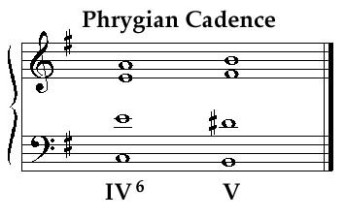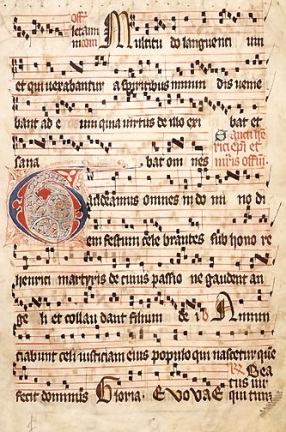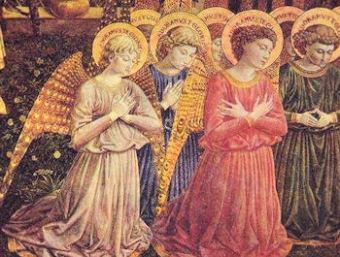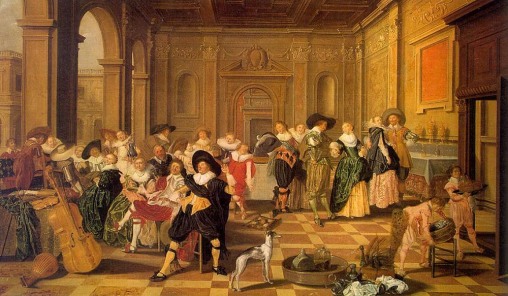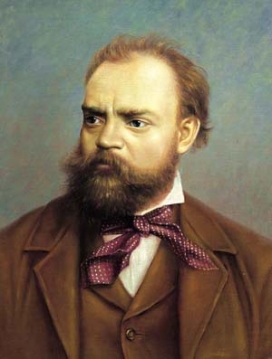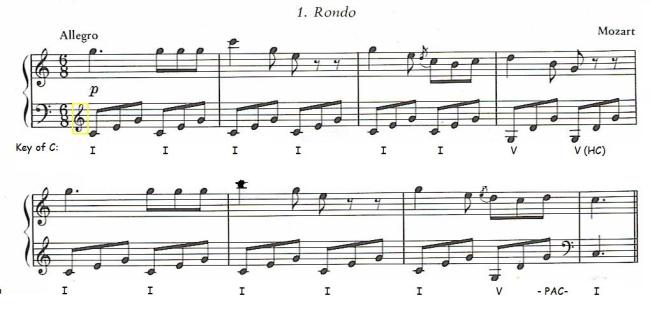In the context of tonal music, a Phrygian cadence is one in which the root of the final chord is approached from a semitone above, most often in the form iv6 – V in minor. A Phrygian cadence is thus a type of half cadence, concluding as it does on the dominant. It is a characteristic gesture of Baroque music and often concludes a slow movement that is to be followed immediately by a faster one.
Monthly Archives: April 2014
homophony
Music in which melodic interest is concentrated in one voice or part that is provided with a subordinate accompaniment, as distinct from polyphony, in which melodic interest is distributed among all parts of the musical texture. The term may refer to a variety of melody-plus-accompaniment textures as weel as to texture, termed homorhythmic, in which all parts move with the same or similar rhythm.
Psalm tone
A melodic formula to which the verses of the Psalms and certain other texts are sung [see Psalmody, Latin]. The use of such tones in the Western Christian rites is linked to the Byzantine practice as is the system of eight *modes with which the Gregorian tones described here are inextricably linked. Although the existence of these tones along with the modes in Gregorian chant is implied in a *tonary of the late 8th century, the earliest preserved source for the tones themselves is a treatise of the 10th century, the Commemoratio brevis de tonis et psalmis modulandis (ed. and trans. Bailey, 1978). The use of psalm tones in other Western rites such as the Ambrosian, Mozarabic, and Old Roman seems not to have been linked to a system of modes.
antiphon
A type of liturgical chant common to the *Gregorian and other Western chant repertories and associated principally with antiphonal psalmody. It is generally a relatively short melody in a simple, syllabic style that serves as a refrain in the singing of the verses of a psalm or canticle. For the relationship of antiphon to accompanying verses and the methods of performing these, see Psalmody, Latin, and Psalm tone.
Offertorium [Lat.]
In Gregorian chant, the item of the Proper of the Mass sung during the presentation of the offering (originally the bread and wine to become the elements of communion). The mention of such a chant by St. Augustine (d. 430) is often interpreted to mean that it originally incorporated a whole Psalm and was thus an example of antiphonal *psalmody. Even though its opening section is consistently identified as an *antiphon, the earliest sources present both antiphons and verses in an extremely ornate or *melismatic style unlike that of other antiphonal pieces. They often employ wide ranges, and some include repetitions of text and melody not found in other types of chant. The two or three verses for each offertory that are included in early sources are unrelated to *psalm tones and do not seem in this context to be remnants of complete Psalms. These verses were gradually discarded beginning in the 12th century and were formally removed in the 16th century by the Council of Trent, except in the Requiem Mass, though their use has been permitted in modern practice, as has the singing of a whole Psalm (LU, p. xvi).
Tafelmusik [Ger., table music]
New World Symphony
[Cz. Z Nového světa, From the New World]. Dvořák’s Ninth Symphony (formerly no. 5) in E minor op. 95 (1893). It was composed during Dvořák’s residence in the U.S. and employs some melodies modeled on traditional African American melodies but does not actually quote any.
Symphony No. 9, “From the New World”: http://www.youtube.com/watch?v=ShmwB7n3H4A
Miroirs [Fr., Mirrors]
Five piano pieces by Ravel, composed in 1905: Noctuelles (Moths); Oiseaux tristes (Mournful Birds); Une barque sur l’océan (A Boat on the Ocean; orchestrated in 1906, rev. 1926); Alborada del gracioso (The Fool’s Dawn Song; orchestrated in 1918); and Le vallée des cloches (The Valley of the Bells).
Listen to Sviatoslav Richter play Miroirs: http://www.youtube.com/watch?v=wj5JxtVXMus
chromatic [Gr., colored]
(1) The scale that includes all of the 12 pitches (and thus all of the 12 semitones) contained in an octave, as distinct from the diatonic scale. (2) Harmony or melody that employs some if not all of the pitches of the chromatic scale in addition to those of the diatonic scale of some particular key, whether or not the harmony or melody in question can be understood within the context of any single key. (3) An instrument capable of playing a chromatic scale, e.g., brass instruments with valves as distinct from the natural instruments [but see also Harp]. (4) One of the three genera (the other two being diatonic and enharmonic) of the music of ancient Greece. It employs a tetrachord bounded by a perfect fourth and in which the lower two intervals are both semitones. (5) [It. cromatico.] In the 16th century, works notated with black notes.
Antecedent, consequent
Two musical phrases, the second of which is a concluding response to or resolution of the first. The two phrases often have the same or similar rhythms, but have complementary pitch contours and/or tonal implications, e.g., a rising contour in the first and a falling contour in the second, or a conclusion on the dominant in the first and a conclusion on the tonic in the second. In the accompanying example from the first movement of Mozart’s Symphony no. 40 in G minor K. 550, this relationship obtains at two levels simultaneously. Phrases c and d for one antecedent-consequent pair, as do phrases e and f. At the same time, the two pairs, understood as phrases A and B, respectively, are also related to one another as antecedent and consequent.
